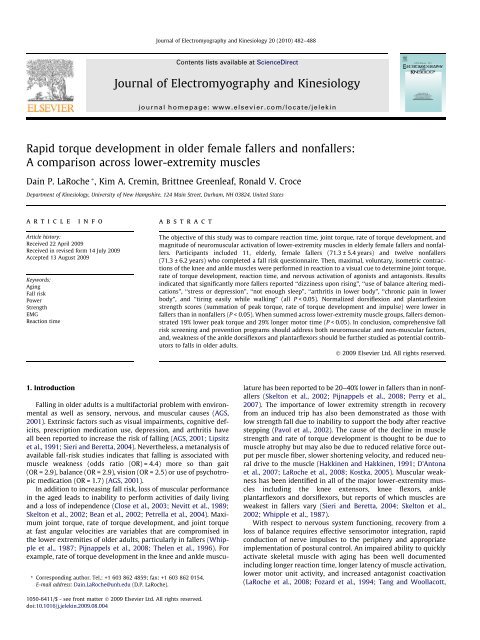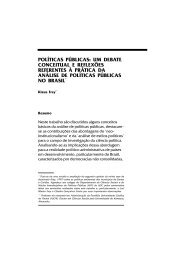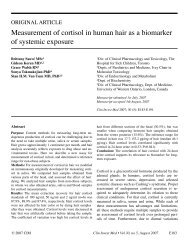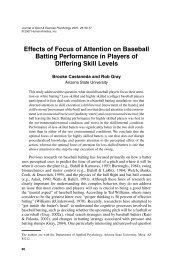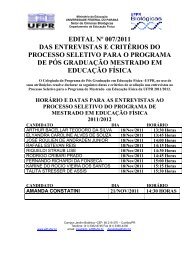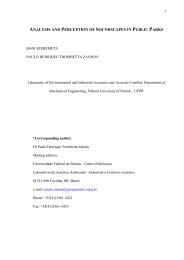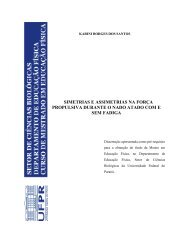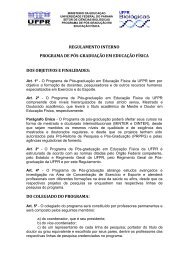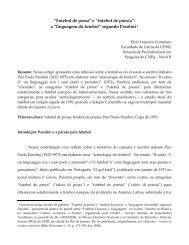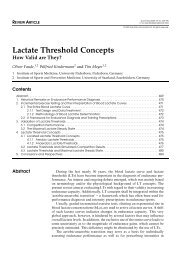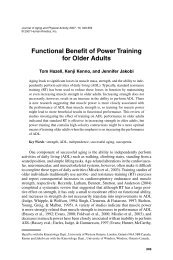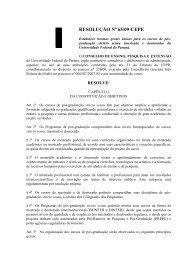Journal of Electromyography and Kinesiology - UFPR
Journal of Electromyography and Kinesiology - UFPR
Journal of Electromyography and Kinesiology - UFPR
You also want an ePaper? Increase the reach of your titles
YUMPU automatically turns print PDFs into web optimized ePapers that Google loves.
<strong>Journal</strong> <strong>of</strong> <strong>Electromyography</strong> <strong>and</strong> <strong>Kinesiology</strong> 20 (2010) 482–488<br />
Contents lists available at ScienceDirect<br />
<strong>Journal</strong> <strong>of</strong> <strong>Electromyography</strong> <strong>and</strong> <strong>Kinesiology</strong><br />
journal homepage: www.elsevier.com/locate/jelekin<br />
Rapid torque development in older female fallers <strong>and</strong> nonfallers:<br />
A comparison across lower-extremity muscles<br />
Dain P. LaRoche * , Kim A. Cremin, Brittnee Greenleaf, Ronald V. Croce<br />
Department <strong>of</strong> <strong>Kinesiology</strong>, University <strong>of</strong> New Hampshire, 124 Main Street, Durham, NH 03824, United States<br />
article<br />
info<br />
abstract<br />
Article history:<br />
Received 22 April 2009<br />
Received in revised form 14 July 2009<br />
Accepted 13 August 2009<br />
Keywords:<br />
Aging<br />
Fall risk<br />
Power<br />
Strength<br />
EMG<br />
Reaction time<br />
The objective <strong>of</strong> this study was to compare reaction time, joint torque, rate <strong>of</strong> torque development, <strong>and</strong><br />
magnitude <strong>of</strong> neuromuscular activation <strong>of</strong> lower-extremity muscles in elderly female fallers <strong>and</strong> nonfallers.<br />
Participants included 11, elderly, female fallers (71.3 ± 5.4 years) <strong>and</strong> twelve nonfallers<br />
(71.3 ± 6.2 years) who completed a fall risk questionnaire. Then, maximal, voluntary, isometric contractions<br />
<strong>of</strong> the knee <strong>and</strong> ankle muscles were performed in reaction to a visual cue to determine joint torque,<br />
rate <strong>of</strong> torque development, reaction time, <strong>and</strong> nervous activation <strong>of</strong> agonists <strong>and</strong> antagonists. Results<br />
indicated that significantly more fallers reported ‘‘dizziness upon rising”, ‘‘use <strong>of</strong> balance altering medications”,<br />
‘‘stress or depression”, ‘‘not enough sleep”, ‘‘arthritis in lower body”, ‘‘chronic pain in lower<br />
body”, <strong>and</strong> ‘‘tiring easily while walking” (all P < 0.05). Normalized dorsiflexion <strong>and</strong> plantarflexion<br />
strength scores (summation <strong>of</strong> peak torque, rate <strong>of</strong> torque development <strong>and</strong> impulse) were lower in<br />
fallers than in nonfallers (P < 0.05). When summed across lower-extremity muscle groups, fallers demonstrated<br />
19% lower peak torque <strong>and</strong> 29% longer motor time (P < 0.05). In conclusion, comprehensive fall<br />
risk screening <strong>and</strong> prevention programs should address both neuromuscular <strong>and</strong> non-muscular factors,<br />
<strong>and</strong>, weakness <strong>of</strong> the ankle dorsiflexors <strong>and</strong> plantarflexors should be further studied as potential contributors<br />
to falls in older adults.<br />
Ó 2009 Elsevier Ltd. All rights reserved.<br />
1. Introduction<br />
* Corresponding author. Tel.: +1 603 862 4859; fax: +1 603 862 0154.<br />
E-mail address: Dain.LaRoche@unh.edu (D.P. LaRoche).<br />
Falling in older adults is a multifactorial problem with environmental<br />
as well as sensory, nervous, <strong>and</strong> muscular causes (AGS,<br />
2001). Extrinsic factors such as visual impairments, cognitive deficits,<br />
prescription medication use, depression, <strong>and</strong> arthritis have<br />
all been reported to increase the risk <strong>of</strong> falling (AGS, 2001; Lipsitz<br />
et al., 1991; Sieri <strong>and</strong> Beretta, 2004). Nevertheless, a metanalysis <strong>of</strong><br />
available fall-risk studies indicates that falling is associated with<br />
muscle weakness (odds ratio (OR) = 4.4) more so than gait<br />
(OR = 2.9), balance (OR = 2.9), vision (OR = 2.5) or use <strong>of</strong> psychotropic<br />
medication (OR = 1.7) (AGS, 2001).<br />
In addition to increasing fall risk, loss <strong>of</strong> muscular performance<br />
in the aged leads to inability to perform activities <strong>of</strong> daily living<br />
<strong>and</strong> a loss <strong>of</strong> independence (Close et al., 2003; Nevitt et al., 1989;<br />
Skelton et al., 2002; Bean et al., 2002; Petrella et al., 2004). Maximum<br />
joint torque, rate <strong>of</strong> torque development, <strong>and</strong> joint torque<br />
at fast angular velocities are variables that are compromised in<br />
the lower extremities <strong>of</strong> older adults, particularly in fallers (Whipple<br />
et al., 1987; Pijnappels et al., 2008; Thelen et al., 1996). For<br />
example, rate <strong>of</strong> torque development in the knee <strong>and</strong> ankle musculature<br />
has been reported to be 20–40% lower in fallers than in nonfallers<br />
(Skelton et al., 2002; Pijnappels et al., 2008; Perry et al.,<br />
2007). The importance <strong>of</strong> lower extremity strength in recovery<br />
from an induced trip has also been demonstrated as those with<br />
low strength fall due to inability to support the body after reactive<br />
stepping (Pavol et al., 2002). The cause <strong>of</strong> the decline in muscle<br />
strength <strong>and</strong> rate <strong>of</strong> torque development is thought to be due to<br />
muscle atrophy but may also be due to reduced relative force output<br />
per muscle fiber, slower shortening velocity, <strong>and</strong> reduced neural<br />
drive to the muscle (Hakkinen <strong>and</strong> Hakkinen, 1991; D’Antona<br />
et al., 2007; LaRoche et al., 2008; Kostka, 2005). Muscular weakness<br />
has been identified in all <strong>of</strong> the major lower-extremity muscles<br />
including the knee extensors, knee flexors, ankle<br />
plantarflexors <strong>and</strong> dorsiflexors, but reports <strong>of</strong> which muscles are<br />
weakest in fallers vary (Sieri <strong>and</strong> Beretta, 2004; Skelton et al.,<br />
2002; Whipple et al., 1987).<br />
With respect to nervous system functioning, recovery from a<br />
loss <strong>of</strong> balance requires effective sensorimotor integration, rapid<br />
conduction <strong>of</strong> nerve impulses to the periphery <strong>and</strong> appropriate<br />
implementation <strong>of</strong> postural control. An impaired ability to quickly<br />
activate skeletal muscle with aging has been well documented<br />
including longer reaction time, longer latency <strong>of</strong> muscle activation,<br />
lower motor unit activity, <strong>and</strong> increased antagonist coactivation<br />
(LaRoche et al., 2008; Fozard et al., 1994; Tang <strong>and</strong> Woollacott,<br />
1050-6411/$ - see front matter Ó 2009 Elsevier Ltd. All rights reserved.<br />
doi:10.1016/j.jelekin.2009.08.004
D.P. LaRoche et al. / <strong>Journal</strong> <strong>of</strong> <strong>Electromyography</strong> <strong>and</strong> <strong>Kinesiology</strong> 20 (2010) 482–488 483<br />
1998). This results in older fallers demonstrating a slowed reaction<br />
to postural disturbances resulting in the need for greater muscular<br />
forces during recovery (Sieri <strong>and</strong> Beretta, 2004; van den Bogert<br />
et al., 2002; Kemoun et al., 2002; Thelen et al., 1997, 2000).<br />
Ambiguity in the literature exists as to which muscle groups<br />
have the greatest loss <strong>of</strong> function <strong>and</strong> which neuromuscular performance<br />
variables are most affected in fallers. Therefore the purpose<br />
<strong>of</strong> this study was to determine how timing <strong>of</strong> muscle<br />
activation, nervous drive to the muscle, <strong>and</strong> muscle strength are<br />
related to a history <strong>of</strong> falls making comparisons across the knee<br />
flexors, knee extensors, ankle plantarflexors <strong>and</strong> dorsiflexors. The<br />
researchers hypothesized that fallers would have slower muscle<br />
activation times, lower strength <strong>and</strong> rate <strong>of</strong> torque development,<br />
<strong>and</strong> reduced nervous drive to the muscle, <strong>and</strong> that these deficits<br />
would be greatest in the rarely trained ankle dorsiflexors. Moreover,<br />
we aim to identify those muscles groups most in need <strong>of</strong><br />
exercise in the elderly <strong>and</strong> to highlight which aspects <strong>of</strong> neuromuscular<br />
performance are mostly impaired in elderly fallers.<br />
2. Methods<br />
2.1. Subjects<br />
A total <strong>of</strong> 23 women aged 65–85 years participated in this<br />
experiment. There were no significant differences between fallers<br />
<strong>and</strong> nonfallers for age, height, mass, BMI or the reported volume<br />
<strong>of</strong> physical activity (see Table 1). The women were categorized as<br />
fallers <strong>and</strong> nonfallers based on the protocol used by Skelton et al.<br />
(2002), <strong>and</strong> were then age-matched across groups. Fallers were defined<br />
as women who had fallen, or nearly fallen but caught themselves<br />
with their upper body, three or more times within the last<br />
year <strong>and</strong> nonfallers had no history <strong>of</strong> unexplained falls. Participants<br />
were independent women capable <strong>of</strong> ambulating without<br />
assistive devices <strong>and</strong> had no known neurological or muscular disorders.<br />
Volunteers were excluded from the study if they had any <strong>of</strong><br />
Table 1<br />
Subject descriptive characteristics.<br />
Fallers<br />
n =11<br />
Nonfallers<br />
n =12<br />
P-value<br />
Age (year) 71.3 ± 5.4 71.2 ± 6.2 0.500<br />
Mass (kg) 73.7 ± 17.6 65.1 ± 12.4 0.163<br />
Height (cm) 163.1 ± 6.2 160.5 ± 6.7 0.203<br />
Body mass index (kg m 2 ) 27.6 ± 5.7 25.2 ± 4.1 0.178<br />
Activity (METs h week 1 ) 27.9 ± 22.2 29.6 ± 31.5 0.379<br />
the following conditions: severe arthritis, severe osteoporosis,<br />
uncontrolled blood pressure over 160/90 mm Hg, neurological disorders,<br />
knee or hip replacement in the dominant leg, <strong>and</strong> evidence<br />
<strong>of</strong> severe heart disease or dysrhythmia. All volunteers were required<br />
to provide written consent from their physician prior to<br />
participation <strong>and</strong> gave their own written informed consent. The<br />
protocol was approved by the University’s Institutional Review<br />
Board for the use <strong>of</strong> human subjects.<br />
2.2. Procedures<br />
Subjects reported to the laboratory on two separate days. The<br />
first visit was reserved for completion <strong>of</strong> interviews, assessment<br />
<strong>of</strong> leg dominance, familiarization <strong>of</strong> equipment <strong>and</strong> experimental<br />
procedures, <strong>and</strong> for recording age, height, mass, <strong>and</strong> body mass index<br />
(BMI). Interviews were conducted to obtain fall history, assess<br />
fall risk factors, <strong>and</strong> determine the volume <strong>of</strong> physical activity performed<br />
over the previous ten years. A fall risk assessment questionnaire<br />
(Table 2) was developed using the ‘‘Guideline for the<br />
Prevention <strong>of</strong> Falls in Older Persons” by the American Geriatrics<br />
Society, British Geriatrics Society, <strong>and</strong> American Academy <strong>of</strong><br />
Orthopedic Surgeons Panel on Falls Prevention (AGS, 2001). This<br />
questionnaire identified factors most closely associated with falls.<br />
Physical activity volume over the previous ten years was estimated<br />
according to the methods <strong>of</strong> Kriska et al. (1990) using published<br />
energy costs for common physical activities (Ainsworth et al.,<br />
1993).<br />
A second visit was scheduled approximately seven days later<br />
<strong>and</strong> included assessments <strong>of</strong> premotor time, motor time, total reaction<br />
time, peak joint torque, time to peak torque, rate <strong>of</strong> torque<br />
development, impulse, the magnitude <strong>of</strong> nervous stimulation <strong>of</strong><br />
the agonists, <strong>and</strong> antagonist coactivation in a visually cued reaction<br />
task. These measures were obtained during maximal voluntary<br />
isometric contractions (MVC) <strong>of</strong> the dominant limb <strong>and</strong><br />
were performed separately for the knee flexors (KF), knee extensors<br />
(KE), ankle plantarflexors (PF) <strong>and</strong> ankle dorsiflexors (DF).<br />
The investigators measured isometric strength as opposed to dynamic<br />
strength so that the time domain variables (premotor time,<br />
motor time, reaction time, time to peak torque, rate <strong>of</strong> torque<br />
development, <strong>and</strong> impulse) would not be influenced by movement<br />
<strong>of</strong> the resistance arm or changes in the length–tension relationship<br />
<strong>of</strong> the muscle during shortening. All measurements were completed<br />
using a HUMAC Norm dynamometer (CSMI, Stoughton,<br />
MA, USA) integrated with a BIOPAC MP100 data acquisition system<br />
that recorded joint torques from the analog output <strong>of</strong> the dynamometer.<br />
Prior to each data collection, the dynamometer was calibrated<br />
according to the manufacturer’s recommendations. Torque<br />
Table 2<br />
Results <strong>of</strong> a questionnaire developed to assess the prevalence <strong>of</strong> factors associated with increased fall risk.<br />
Fallers (% responding yes) Nonfallers (% responding yes) P-value<br />
Do you ever feel dizzy after getting up from a seated or lying down position? 27 0 0.029 *<br />
Do you ever feel dizzy for no apparent reason? 36 8 0.055<br />
Do you take medications for depression, anxiety, seizure prevention or as a sleep aid? 45 8 0.024 *<br />
Do you take two or more medications (excluding vitamins <strong>and</strong> supplements)? 73 42 0.071<br />
Do you have Diabetes? 9 0 0.148<br />
Do you suffer from high levels <strong>of</strong> stress or depression? 27 0 0.029 *<br />
Do you wear visual aids? 100 100 0.50<br />
Do you have trouble sleeping which results in not enough sleep? 64 8 0.004 *<br />
Do you have arthritis in the spine or lower limbs? 82 25 0.004 *<br />
Have you been diagnosed with osteoporosis? 18 17 0.463<br />
Do you have chronic muscle pain in the torso or lower limbs? 27 0 0.029 *<br />
Do you have difficulty walking or use a gait aid to help you walk? 0 0 0.500<br />
Do you have trouble getting up out <strong>of</strong> a chair or getting up when you are lying down? 18 0 0.066<br />
Do you tire easily when you walk on a flat surface? 27 0 0.029 *<br />
* P 6 0.05.
484 D.P. LaRoche et al. / <strong>Journal</strong> <strong>of</strong> <strong>Electromyography</strong> <strong>and</strong> <strong>Kinesiology</strong> 20 (2010) 482–488<br />
from the load cell <strong>of</strong> the dynamometer was sampled at 1 kHz, <strong>and</strong><br />
smoothed using the mean torque calculated over overlapping 50-<br />
sample (20 ms) epochs to minimize noise in the precontraction<br />
torque signal such that the onset <strong>of</strong> torque could be easily <strong>and</strong> reliably<br />
detected.<br />
For KE <strong>and</strong> KF muscle testing, participants were placed on the<br />
dynamometer in a seated position with a hip angle <strong>of</strong> 90° <strong>and</strong> knee<br />
angle <strong>of</strong> 75° (full KE equal to 0°). Participants were secured to the<br />
dynamometer in a prone position for DF <strong>and</strong> PF muscle testing with<br />
a90° angle at the ankle. The participants’ torso <strong>and</strong> active leg were<br />
restrained using nylon straps to prevent changes in joint angle that<br />
would influence the length <strong>of</strong> the tested muscle <strong>and</strong> subsequently<br />
joint torque. This restraint also served to limit the biarticular muscles<br />
to the desired joint action. After the participants were secured,<br />
they performed a MVC, with no time constraints, in order to record<br />
peak EMG so that the reaction task trial EMG could be normalized to<br />
peak. Participants were then asked to produce a MVC as quickly as<br />
possible in reaction to a visual cue. Three trials were completed for<br />
each <strong>of</strong> the four muscle groups with the first being used for practice<br />
<strong>and</strong> the mean <strong>of</strong> the last two trials used for analysis. The duration <strong>of</strong><br />
the visual cue was 2 s; so each muscular contraction lasted approximately<br />
2 s with 60 s rest between each trial. Because <strong>of</strong> the required<br />
high rate <strong>of</strong> torque development in this task, the term peak<br />
torque is used in this manuscript to indicate that the highest trial<br />
torque may not be representative <strong>of</strong> the true maximum torque.<br />
The sequence <strong>of</strong> muscle groups tested was conducted in stratified<br />
r<strong>and</strong>om order to prevent any order effect.<br />
Electromyograms (EMG) were recorded from the surface <strong>of</strong> the<br />
skin using disposable, self-adhesive, 1 cm in diameter, silversilver-chloride,<br />
wet gel electrodes (Vermed, Inc., Bellows Falls,<br />
Vermont, USA). After the skin was cleaned <strong>and</strong> abraded to achieve<br />
a skin impedance <strong>of</strong>
D.P. LaRoche et al. / <strong>Journal</strong> <strong>of</strong> <strong>Electromyography</strong> <strong>and</strong> <strong>Kinesiology</strong> 20 (2010) 482–488 485<br />
torque development, impulse, nervous stimulation <strong>of</strong> agonists, <strong>and</strong><br />
antagonist coactivation. Differences between groups were assessed<br />
using a Mann–Whitney test <strong>and</strong> the rejection criterion was set at<br />
P 6 0.05. This statistical test was chosen because <strong>of</strong> the inclusion<br />
<strong>of</strong> ordinal scale variables <strong>and</strong> lack <strong>of</strong> normal distribution for a number<br />
<strong>of</strong> dependent variables.<br />
3. Results<br />
Significantly more fallers reported dizziness upon rising, use <strong>of</strong><br />
balance altering medications, stress or depression, not enough<br />
sleep, arthritis in lower body, chronic pain in lower body, <strong>and</strong> tiring<br />
easily while walking (Table 2). Comparison <strong>of</strong> composite scores between<br />
muscles for muscle activation timing, strength, <strong>and</strong> nervous<br />
activation indicated that only dorsiflexion <strong>and</strong> plantarflexion<br />
strength scores (summation <strong>of</strong> peak torque, rate <strong>of</strong> torque development<br />
<strong>and</strong> impulse) were different between fallers <strong>and</strong> nonfallers<br />
(P = 0.048, P = 0.01 respectively). When comparing the composite<br />
scores for each <strong>of</strong> the measured variables summed across lowerextremity<br />
muscle groups, only peak torque <strong>and</strong> motor time were<br />
significantly different between fallers <strong>and</strong> nonfallers (P = 0.022,<br />
P = 0.014). No differences between groups were found for total<br />
reaction time, premotor time, time to peak torque, rate <strong>of</strong> torque<br />
development, impulse, or levels <strong>of</strong> agonist or antagonist activation.<br />
Means <strong>and</strong> st<strong>and</strong>ard deviations for the temporal components <strong>of</strong><br />
muscle activation may be seen in Table 3, strength parameters in<br />
Table 4, <strong>and</strong> muscle activation parameters in Table 5.<br />
4. Discussion<br />
There were several important findings in this study. First, fallers<br />
reported more non-muscular fall risk factors including experiencing<br />
dizziness upon rising, taking balance altering medications, suffering<br />
from stress <strong>and</strong>/or depression, sleep deprivation, fatigue<br />
while walking on a flat surface, chronic pain, <strong>and</strong> arthritis in the<br />
lower extremities. The fallers demonstrated lower strength (peak<br />
torque) when summed across all muscle groups in comparison to<br />
nonfallers. Specifically, fallers had the greatest deficits in peak torque,<br />
rate <strong>of</strong> torque development, <strong>and</strong> impulse in the ankle dorsiflexors<br />
<strong>and</strong> plantarflexors with no differences between groups for<br />
these variables in the knee flexors <strong>and</strong> extensors. Thirdly, fallers<br />
exhibited longer motor times than their non-falling peers. These<br />
results suggest the presence <strong>of</strong> multiple non-muscular risk factors,<br />
slowed excitation–contraction coupling, <strong>and</strong> strength <strong>and</strong> rate <strong>of</strong><br />
torque development deficits in the ankle musculature in these<br />
subjects.<br />
4.1. Non-muscular fall risk factors<br />
The current study supports previous findings that have indicated<br />
that stress, depression, the use <strong>of</strong> balance altering medications,<br />
<strong>and</strong> vertigo upon rising are risk factors related to falls in<br />
older persons (AGS, 2001; Lipsitz et al., 1991; Sieri <strong>and</strong> Beretta,<br />
2004). These factors are likely interrelated with depression leading<br />
to the use <strong>of</strong> anti-depressants <strong>and</strong> their deleterious effects. Antidepressants<br />
(Ryynanen et al., 1993), along with sedatives (Speechley<br />
<strong>and</strong> Tinetti, 1991), psychotropic (Campbell, 1990) <strong>and</strong> anti-seizure<br />
medications can impair the central or peripheral nervous<br />
system, can cause postural hypotension, drowsiness <strong>and</strong> decreased<br />
awareness <strong>of</strong> surroundings (Cranwell-Bruce, 2008). Additionally,<br />
the present study reported that 64% <strong>of</strong> the fallers suffered from<br />
sleep deprivation while only 8% <strong>of</strong> nonfallers did. Although a lack<br />
<strong>of</strong> sleep has been linked to stress <strong>and</strong> depression, it has been identified<br />
as an independent fall risk factor (AGS, 2001). Perhaps elderly<br />
Table 3<br />
Premotor time, motor time, reaction time, <strong>and</strong> time to peak torque in the leg muscles <strong>of</strong> fallers <strong>and</strong> nonfallers obtained from a visually cued maximal voluntary isometric<br />
contraction. Values are mean ± SD. Composite Z-score by muscle = mean <strong>of</strong> premotor time, motor time, reaction time, <strong>and</strong> time to peak torque Z-scores. Composite score by<br />
variable = mean <strong>of</strong> knee extensors, knee flexors, dorsiflexors, <strong>and</strong> plantarflexors Z-scores for a given variable.<br />
* Difference in composite Z-score between groups; P 6 0.05.<br />
Table 4<br />
Peak torque, power <strong>and</strong> impulse in the leg muscles <strong>of</strong> fallers <strong>and</strong> nonfallers obtained from a visually cued maximal voluntary isometric contraction. Values are mean ± SD.<br />
Composite Z-score by muscle = mean <strong>of</strong> peak torque, rate <strong>of</strong> torque development, <strong>and</strong> impulse Z-scores. Composite score by variable = mean <strong>of</strong> knee extensors, knee flexors,<br />
dorsiflexors, <strong>and</strong> plantarflexors Z-scores for a given variable.<br />
* Difference in composite Z-score between groups; P 6 0.05.
486 D.P. LaRoche et al. / <strong>Journal</strong> <strong>of</strong> <strong>Electromyography</strong> <strong>and</strong> <strong>Kinesiology</strong> 20 (2010) 482–488<br />
Table 5<br />
Nervous activation for agonist <strong>and</strong> antagonist muscles in the leg <strong>of</strong> fallers <strong>and</strong> nonfallers obtained from a visually cued maximal voluntary isometric contraction. Values are<br />
mean ± SD. Composite Z-score by muscle = mean <strong>of</strong> agonist integrated EMG <strong>and</strong> the inverse <strong>of</strong> antagonist integrated EMG Z-scores. Composite score by variable = mean <strong>of</strong> knee<br />
extensors, knee flexors, dorsiflexors, <strong>and</strong> plantarflexors Z-scores for a given variable.<br />
fallers are fatigued during the day or up at night while nonfallers<br />
are resting well.<br />
In the present study, 82% <strong>of</strong> fallers reported arthritis in the lower<br />
extremities compared to only 25% <strong>of</strong> nonfallers, <strong>and</strong>, 27% <strong>of</strong> fallers<br />
reported having chronic pain in the legs while no nonfallers<br />
reported chronic pain. It has been demonstrated that arthritic<br />
symptoms are associated with low levels <strong>of</strong> physical activity<br />
(Heesch et al., 2007). Therefore, arthritis probably leads to a decline<br />
in physical activity, which leads to deconditioning, which increases<br />
the likelihood <strong>of</strong> falls. In support <strong>of</strong> this hypothesis, this<br />
study showed impaired muscular performance in fallers <strong>and</strong> 27%<br />
<strong>of</strong> fallers reported fatiguing easily while walking on a flat surface<br />
while none <strong>of</strong> the nonfallers did. These results are in accordance<br />
with others (Kemoun et al., 2002; Verghese et al., 2006; Luukinen<br />
et al., 1994) <strong>and</strong> provide further support for the link between arthritic<br />
pain, fatigue, <strong>and</strong> fall risk in older adults.<br />
4.2. Muscle strength <strong>and</strong> power<br />
Joint rate <strong>of</strong> torque development is important in fall prevention<br />
(Overend et al., 1992) because it allows an individual to react<br />
quickly to a postural perturbation <strong>and</strong> to support their body weight<br />
during reactive stepping (Lanza et al., 2003). Previous researchers<br />
have shown that low levels <strong>of</strong> composite strength <strong>and</strong> power <strong>of</strong><br />
the leg muscles contribute to fall incidents (Whipple et al., 1987;<br />
Perry et al., 2007). Similarly, the current study shows that, averaged<br />
across all muscle groups, peak torque was 19% lower in older<br />
female fallers. This lends further support for the relationship between<br />
muscle weakness <strong>and</strong> a history <strong>of</strong> falls. However, there are<br />
disparities in the literature as to which muscles contribute most<br />
to increase the risk for falls in the elderly. Some studies have found<br />
the DF to be the most impaired in fallers (Skelton et al., 2002;<br />
Whipple et al., 1987); others found the greatest deficiency in the<br />
PF (Sieri <strong>and</strong> Beretta, 2004; Perry et al., 2007), while others found<br />
weakness in the KE <strong>and</strong>/or the KF (Sieri <strong>and</strong> Beretta, 2004; Takazawa<br />
et al., 2003). Such disparities may be attributed to the different<br />
methodologies used, age <strong>and</strong> gender differences, different types <strong>of</strong><br />
contractions performed, <strong>and</strong>, during dynamic contractions, varying<br />
velocities <strong>and</strong> range <strong>of</strong> motions. This study, for example, used isometric<br />
contractions that elicit repeatable strength measurement<br />
over time, but are not characteristic <strong>of</strong> the dynamic movements required<br />
during locomotion <strong>and</strong> recovery from a loss <strong>of</strong> balance.<br />
Nonetheless, the results obtained in the present study are consistent<br />
with those obtained by Skelton et al. (2002), Whipple et al.<br />
(1987) <strong>and</strong> Perry et al. (2007) in that DF <strong>and</strong> PF strength <strong>and</strong> rate <strong>of</strong><br />
torque development were lower in fallers than in nonfallers. Specifically,<br />
older female fallers had 16% lower DF peak torque, 27%<br />
lower PF torque, 19% lower DF rate <strong>of</strong> torque development, 23%<br />
lower PF rate <strong>of</strong> torque development, 6% lower DF impulse, <strong>and</strong><br />
28% lower PF impulse during a rapid contraction. It is likely that<br />
these two particular muscle groups are associated with falling for<br />
two reasons: (1) the PF <strong>and</strong> DF muscles are critical for maintaining<br />
balance after a postural disturbance <strong>and</strong> (2) the PF <strong>and</strong> DF muscles<br />
are required for normal walking gait. It has long been known that<br />
the DF <strong>and</strong> PF muscles are the first line <strong>of</strong> defense in st<strong>and</strong>ing postural<br />
control (Nashner, 1977) <strong>and</strong> more recent research suggests<br />
that during reactive stepping the ankle muscles are activated first<br />
before the muscles <strong>of</strong> the knee <strong>and</strong> hip (Thelen et al., 1997). If<br />
strength in the ankle musculature is insufficient to control balance,<br />
individuals must then adopt hip or stepping strategies. These strategies<br />
require larger gross movements <strong>and</strong> displacement <strong>of</strong> the center<br />
<strong>of</strong> mass, require higher forces, possibly leading to further loss <strong>of</strong><br />
balance <strong>and</strong> falls.<br />
As for walking gait, Kemoun et al. observed that during the<br />
‘‘swing” <strong>and</strong> ‘‘toe <strong>of</strong>f” phases the ankles <strong>of</strong> fallers moved through<br />
a lower range <strong>of</strong> motion than nonfallers <strong>and</strong> display delayed DF<br />
activation (Kemoun et al., 2002). The lower DF peak torque seen<br />
in the current study may be associated with foot drop when walking<br />
which would reduce the ability to clear obstacles possibly<br />
increasing the frequency <strong>of</strong> tripping. The lower PF peak torque, rate<br />
<strong>of</strong> torque development <strong>and</strong> impulse seen in this study more likely<br />
attenuate propulsion during walking <strong>and</strong> inhibit recovery during<br />
loss <strong>of</strong> balance as has been previously demonstrated (Kerrigan<br />
et al., 1998; Mueller et al., 1995; Nadeau et al., 1999; Pijnappels<br />
et al., 2005). Specifically, Pijnappels et al. (2005) demonstrated that<br />
during push-<strong>of</strong>f following a trip, older fallers showed the greatest<br />
deficits in ankle <strong>and</strong> hip rate <strong>of</strong> torque development <strong>and</strong> demonstrated<br />
lower peak torque only for ankle plantarflexion. These<br />
weaknesses translated into an inability to control forward momentum<br />
leading to falls for these subjects. The current study is in<br />
agreement with these findings. Since no deficiencies were found<br />
for the muscles <strong>of</strong> the knee in the falling group, performance <strong>of</strong><br />
the ankle musculature appears to be more associated with a history<br />
<strong>of</strong> falling in this experimental group. It is possible that by performing<br />
activities <strong>of</strong> daily living (sit to st<strong>and</strong>, stair climbing) or<br />
through participation in recreational activities like walking <strong>and</strong><br />
gardening, the knee muscles are exercised to a greater degree than<br />
the ankle muscles. In fact, a secondary examination <strong>of</strong> the data<br />
indicated that by separating participants into the most <strong>and</strong> least<br />
active (ignoring fall history), KE <strong>and</strong> KF strength <strong>and</strong> rate <strong>of</strong> torque<br />
development tracked well with reported physical activity level<br />
while DF <strong>and</strong> PF performance did not.<br />
4.3. Time course <strong>of</strong> muscle activation<br />
A slow response time has been linked to falls (Maki, 1997; Larsson<br />
et al., 1979) <strong>and</strong> difficulty recovering loss <strong>of</strong> balance (Thelen<br />
et al., 1997), but there is little research on muscle activation time<br />
<strong>of</strong> individual muscle groups in older fallers. When the temporal<br />
factors <strong>of</strong> muscle activation (premotor time, motor time, total reaction<br />
time, <strong>and</strong> time to peak torque) were summated <strong>and</strong> compared<br />
between muscle groups there were no significant differences in<br />
muscle activation latencies between fallers <strong>and</strong> nonfallers. This<br />
indicates that in response to a visual cue during isolated, uniaxial
D.P. LaRoche et al. / <strong>Journal</strong> <strong>of</strong> <strong>Electromyography</strong> <strong>and</strong> <strong>Kinesiology</strong> 20 (2010) 482–488 487<br />
contractions, muscle activation time in the muscles studied is not<br />
strongly associated with a history <strong>of</strong> falls. However, when each<br />
temporal component was summed across muscle groups <strong>and</strong><br />
examined independently, motor time was 22 ms longer (29%) in<br />
fallers. Motor time, the time from nervous activation to torque production,<br />
is longer in less active individuals (Bunce et al., 2004; LaRoche<br />
et al., 2007) <strong>and</strong> it increases with age (Bunce et al., 2004).<br />
Likely, the slowed motor time <strong>of</strong> fallers is representative <strong>of</strong> diminished<br />
excitation–contraction coupling including slowed calcium<br />
release or reuptake from the sarcoplasmic reticulum <strong>and</strong> decreased<br />
activity <strong>of</strong> metabolic enzymes such as creatine kinase <strong>and</strong> actomyosin<br />
ATPase (Prochniewicz et al., 2005; Kaczor et al., 2006; Pastoris<br />
et al., 2000). Alternatively, if fallers had reduced muscle mass <strong>and</strong><br />
cross-sectional area, the slower motor time may have been due to<br />
reduced musculotendinous stiffness that would result in less<br />
immediate transfer <strong>of</strong> force from the muscle to the bone (Magnusson<br />
et al., 1997). In fact, elderly have been shown to have tendons<br />
that are less stiff than young yet have the capacity to increase stiffness<br />
by more than 60% following resistance training (Reeves et al.,<br />
2003). It is therefore logical that the longer motor time seen in elderly<br />
fallers covaries with reduced strength.<br />
4.4. Muscle EMG activity<br />
Because aging (LaRoche et al., 2008; Laughton et al., 2003) <strong>and</strong><br />
low levels <strong>of</strong> physical activity (LaRoche et al., 2007) have been<br />
associated with decreased neural drive, it was hypothesized that<br />
decreased agonist activation might contribute to the lower<br />
strength <strong>and</strong> rate <strong>of</strong> torque development seen in older female fallers.<br />
Unexpectedly, the magnitude <strong>of</strong> neuromuscular activation <strong>of</strong><br />
the agonist muscles in the first 200 ms <strong>of</strong> contraction was not different<br />
between fallers <strong>and</strong> nonfallers for any <strong>of</strong> the actions performed.<br />
Also, it was hypothesized that greater levels <strong>of</strong><br />
antagonist coactivation in older female fallers might contribute<br />
to reduced net joint torque, slowed movements, <strong>and</strong> their inability<br />
to appropriately respond to postural disturbances but this too was<br />
not supported by the current study. These findings indicate that in<br />
this group <strong>of</strong> women, when performing simple, single joint<br />
strength tasks, that performance <strong>of</strong> the motor system does not distinguish<br />
between fallers <strong>and</strong> nonfallers.<br />
4.5. Limitations<br />
A major limitation <strong>of</strong> this study was that it was cross-sectional<br />
in nature <strong>and</strong> did not prospectively determine the relationship between<br />
neuromuscular performance <strong>and</strong> fall risk. A significant<br />
health disparity was identified between fallers <strong>and</strong> nonfallers with<br />
fallers reporting more medication use, arthritis, pain, <strong>and</strong> fatigue.<br />
Because <strong>of</strong> the study design, it is not possible to differentiate to<br />
what extent the neuromuscular performance deficits or impaired<br />
general health contributed to the greater history <strong>of</strong> falls. Lastly,<br />
the performance <strong>of</strong> the hip musculature was not assessed in this<br />
study despite its documented importance in recovery from loss<br />
<strong>of</strong> balance (Thelen et al., 2000).<br />
5. Conclusions<br />
This study indicates that poor health <strong>and</strong> poor muscular fitness<br />
are comorbid conditions likely to be seen in elderly fallers. This was<br />
demonstrated by diminished lower extremity strength <strong>and</strong> a higher<br />
prevalence <strong>of</strong> non-muscular fall risk factors in older female fallers.<br />
The results suggest that strength, speed <strong>of</strong> movement, <strong>and</strong> power <strong>of</strong><br />
the ankle dorsiflexors <strong>and</strong> plantarflexors should be further studied<br />
as potential contributors to falls in older adults. Secondly, interventions<br />
designed to reduce falls might help control the number <strong>and</strong><br />
type <strong>of</strong> medication use, as well as reduce fatigue, stress <strong>and</strong> chronic<br />
pain. Finally, the determination <strong>of</strong> specific muscular weaknesses<br />
<strong>and</strong> fall risk factors should be used to design individualized fall prevention<br />
programs that are likely to be more successful than generalized<br />
fall prevention programs (Tinetti et al., 1994).<br />
Financial disclosure<br />
We certify that no party having a direct interest in the results <strong>of</strong><br />
the research supporting this article has or will confer a benefit on<br />
us or on any organization with which we are associated AND, if<br />
applicable, we certify that all financial <strong>and</strong> material support for this<br />
research (e.g., NIH or NHS grants) <strong>and</strong> work are clearly identified in<br />
the title page <strong>of</strong> the manuscript.<br />
Conflict <strong>of</strong> interest<br />
None.<br />
References<br />
AGS. Guideline for the prevention <strong>of</strong> falls in older persons. American Geriatrics<br />
Society, British Geriatrics Society, <strong>and</strong> American Academy <strong>of</strong> Orthopaedic<br />
Surgeons Panel on Falls Prevention. J Am Geriatr Soc 2001;49(5):664–72.<br />
Ainsworth BE, Haskell WL, Leon AS, Jacobs Jr DR, Montoye HJ, Sallis JF, et al.<br />
Compendium <strong>of</strong> physical activities: classification <strong>of</strong> energy costs <strong>of</strong> human<br />
physical activities. Med Sci Sports Exerc 1993;25(1):71–80.<br />
Bean JF, Kiely DK, Herman S, Leveille SG, Mizer K, Frontera WR, et al. The<br />
relationship between leg power <strong>and</strong> physical performance in mobility-limited<br />
older people. J Am Geriatr Soc 2002;50(3):461–7.<br />
Bunce D, MacDonald SW, Hultsch DF. Inconsistency in serial choice decision <strong>and</strong><br />
motor reaction times dissociate in younger <strong>and</strong> older adults. Brain Cogn<br />
2004;56(3):320–7.<br />
Campbell AJ. Falls, fractures <strong>and</strong> drugs. N Z Med J 1990;103(903):580–1.<br />
Close JC, Hooper R, Glucksman E, Jackson SH, Swift CG. Predictors <strong>of</strong> falls in a high<br />
risk population: results from the prevention <strong>of</strong> falls in the elderly trial (PROFET).<br />
Emerg Med J 2003;20(5):421–5.<br />
Cranwell-Bruce LA. The connection between patient falls <strong>and</strong> medication. Medsurg<br />
Nurs 2008;17(3):189–91. quiz 92.<br />
D’Antona G, Pellegrino MA, Carlizzi CN, Bottinelli R. Deterioration <strong>of</strong> contractile<br />
properties <strong>of</strong> muscle fibres in elderly subjects is modulated by the level <strong>of</strong><br />
physical activity. Eur J Appl Physiol 2007;100(5):603–11.<br />
Fozard JL, Vercryssen M, Reynolds SL, Hancock PA, Quilter RE. Age differences <strong>and</strong><br />
changes in reaction time: the Baltimore longitudinal study <strong>of</strong> aging. J Gerontol<br />
1994;49(4):P179–89.<br />
Hakkinen K, Hakkinen A. Muscle cross-sectional area, force production <strong>and</strong><br />
relaxation characteristics in women at different ages. Eur J Appl Physiol<br />
Occup Physiol 1991;62(6):410–4.<br />
Heesch KC, Miller YD, Brown WJ. Relationship between physical activity <strong>and</strong> stiff or<br />
painful joints in mid-aged women <strong>and</strong> older women: a 3-year prospective<br />
study. Arthritis Res Ther 2007;9(2):R34.<br />
Kaczor JJ, Ziolkowski W, Antosiewicz J, Hac S, Tarnopolsky MA, Popinigis J. The effect<br />
<strong>of</strong> aging on anaerobic <strong>and</strong> aerobic enzyme activities in human skeletal muscle. J<br />
Gerontol A Biol Sci Med Sci 2006;61(4):339–44.<br />
Kemoun G, Thoumie P, Boisson D, Guieu JD. Ankle dorsiflexion delay can predict<br />
falls in the elderly. J Rehabil Med 2002;34(6):278–83.<br />
Kerrigan DC, Todd MK, Della Croce U, Lipsitz LA, Collins JJ. Biomechanical gait<br />
alterations independent <strong>of</strong> speed in the healthy elderly: evidence for specific<br />
limiting impairments. Arch Phys Med Rehabil 1998;79(3):317–22.<br />
Kostka T. Quadriceps maximal power <strong>and</strong> optimal shortening velocity in 335 men<br />
aged 23–88 years. Eur J Appl Physiol 2005;95(2–3):140–5.<br />
Kriska AM, Knowler WC, LaPorte RE, Drash AL, Wing RR, Blair SN, et al. Development<br />
<strong>of</strong> questionnaire to examine relationship <strong>of</strong> physical activity <strong>and</strong> diabetes in<br />
Pima Indians. Diabetes Care 1990;13(4):401–11.<br />
Lanza IR, Towse TF, Caldwell GE, Wigmore DM, Kent-Braun JA. Effects <strong>of</strong> age on<br />
human muscle torque, velocity, <strong>and</strong> power in two muscle groups. J Appl Physiol<br />
2003;95(6):2361–9.<br />
LaRoche DP, Knight CA, Dickie JL, Lussier MV, Roy SJ. Explosive force <strong>and</strong><br />
fractionated reaction time in elderly low <strong>and</strong> high active women. Med Sci<br />
Sports Exerc 2007;39(9):1659–65.<br />
LaRoche DP, Roy SJ, Knight CA, Dickie JL. Elderly women have blunted response to<br />
resistance training despite reduced antagonist coactivation. Med Sci Sports<br />
Exerc 2008;40:1660–8.<br />
Larsson L, Grimby G, Karlsson J. Muscle strength <strong>and</strong> speed <strong>of</strong> movement in relation<br />
to age <strong>and</strong> muscle morphology. J Appl Physiol 1979;46(3):451–6.<br />
Laughton CA, Slavin M, Katdare K, Nolan L, Bean JF, Kerrigan DC, et al. Aging, muscle<br />
activity, <strong>and</strong> balance control: physiologic changes associated with balance<br />
impairment. Gait Posture 2003;18(2):101–8.<br />
Lipsitz LA, Jonsson PV, Kelley MM, Koestner JS. Causes <strong>and</strong> correlates <strong>of</strong> recurrent<br />
falls in ambulatory frail elderly. J Gerontol 1991;46(4):M114–22.
488 D.P. LaRoche et al. / <strong>Journal</strong> <strong>of</strong> <strong>Electromyography</strong> <strong>and</strong> <strong>Kinesiology</strong> 20 (2010) 482–488<br />
Luukinen H, Koski K, Hiltunen L, Kivela SL. Incidence rate <strong>of</strong> falls in an aged<br />
population in northern Finl<strong>and</strong>. J Clin Epidemiol 1994;47(8):843–50.<br />
Magnusson SP, Simonsen EB, Aagaard P, Boesen J, Johannsen F, Kjaer M.<br />
Determinants <strong>of</strong> musculoskeletal flexibility: viscoelastic properties, crosssectional<br />
area, EMG <strong>and</strong> stretch tolerance. Sc<strong>and</strong> J Med Sci Sports<br />
1997;7(4):195–202.<br />
Maki BE. Gait changes in older adults: predictors <strong>of</strong> falls or indicators <strong>of</strong> fear. J Am<br />
Geriatr Soc 1997;45(3):313–20.<br />
Mueller MJ, Minor SD, Schaaf JA, Strube MJ, Sahrmann SA. Relationship <strong>of</strong> plantarflexor<br />
peak torque <strong>and</strong> dorsiflexion range <strong>of</strong> motion to kinetic variables during<br />
walking. Phys Ther 1995;75(8):684–93.<br />
Nadeau S, Gravel D, Arsenault AB, Bourbonnais D. Plantarflexor weakness as a<br />
limiting factor <strong>of</strong> gait speed in stroke subjects <strong>and</strong> the compensating role <strong>of</strong> hip<br />
flexors. Clin Biomech (Bristol, Avon) 1999;14(2):125–35.<br />
Nashner LM. Fixed patterns <strong>of</strong> rapid postural responses among leg muscles during<br />
stance. Exp Brain Res 1977;30(1):13–24.<br />
Nevitt MC, Cummings SR, Kidd S, Black D. Risk factors for recurrent nonsyncopal<br />
falls. A prospective study. JAMA 1989;261(18):2663–8.<br />
Overend TJ, Cunningham DA, Kramer JF, Lefcoe MS, Paterson DH. Knee extensor <strong>and</strong><br />
knee flexor strength: cross-sectional area ratios in young <strong>and</strong> elderly men. J<br />
Gerontol 1992;47(6):M204–10.<br />
Pastoris O, Boschi F, Verri M, Baiardi P, Felzani G, Vecchiet J, et al. The effects <strong>of</strong><br />
aging on enzyme activities <strong>and</strong> metabolite concentrations in skeletal muscle<br />
from sedentary male <strong>and</strong> female subjects. Exp Gerontol 2000;35(1):95–104.<br />
Pavol MJ, Owings TM, Foley KT, Grabiner MD. Influence <strong>of</strong> lower extremity strength<br />
<strong>of</strong> healthy older adults on the outcome <strong>of</strong> an induced trip. J Am Geriatr Soc<br />
2002;50(2):256–62.<br />
Perry MC, Carville SF, Smith IC, Rutherford OM, Newham DJ. Strength, power output<br />
<strong>and</strong> symmetry <strong>of</strong> leg muscles: effect <strong>of</strong> age <strong>and</strong> history <strong>of</strong> falling. Eur J Appl<br />
Physiol 2007;100(5):553–61.<br />
Petrella JK, Miller LS, Cress ME. Leg extensor power, cognition, <strong>and</strong> functional<br />
performance in independent <strong>and</strong> marginally dependent older adults. Age<br />
Ageing 2004;33(4):342–8.<br />
Pijnappels M, Bobbert MF, van Dieen JH. Push-<strong>of</strong>f reactions in recovery after<br />
tripping discriminate young subjects, older non-fallers <strong>and</strong> older fallers. Gait<br />
Posture 2005;21(4):388–94.<br />
Pijnappels M, van der Burg PJ, Reeves ND, van Dieen JH. Identification <strong>of</strong> elderly<br />
fallers by muscle strength measures. Eur J Appl Physiol 2008;102(5):585–92.<br />
Prochniewicz E, Thomas DD, Thompson LV. Age-related decline in actomyosin<br />
function. J Gerontol A Biol Sci Med Sci 2005;60(4):425–31.<br />
Reeves ND, Narici MV, Maganaris CN. Strength training alters the viscoelastic<br />
properties <strong>of</strong> tendons in elderly humans. Muscle Nerve 2003;28(1):74–81.<br />
Ryynanen OP, Kivela SL, Honkanen R, Laippala P, Saano V. Medications <strong>and</strong> chronic<br />
diseases as risk factors for falling injuries in the elderly. Sc<strong>and</strong> J Soc Med<br />
1993;21(4):264–71.<br />
Sieri T, Beretta G. Fall risk assessment in very old males <strong>and</strong> females living in<br />
nursing homes. Disabil Rehabil 2004;26(12):718–23.<br />
Skelton DA, Kennedy J, Rutherford OM. Explosive power <strong>and</strong> asymmetry in leg<br />
muscle function in frequent fallers <strong>and</strong> non-fallers aged over 65. Age Ageing<br />
2002;31(2):119–25.<br />
Speechley M, Tinetti M. Falls <strong>and</strong> injuries in frail <strong>and</strong> vigorous community elderly<br />
persons. J Am Geriatr Soc 1991;39(1):46–52.<br />
Takazawa K, Arisawa K, Honda S, Shibata Y, Saito H. Lower-extremity muscle forces<br />
measured by a h<strong>and</strong>-held dynamometer <strong>and</strong> the risk <strong>of</strong> falls among day-care<br />
users in Japan: using multinomial logistic regression analysis. Disabil Rehabil<br />
2003;25(8):399–404.<br />
Tang PF, Woollacott MH. Inefficient postural responses to unexpected slips during<br />
walking in older adults. J Gerontol A Biol Sci Med Sci 1998;53(6):M471–80.<br />
Thelen DG, Schultz AB, Alex<strong>and</strong>er NB, Ashton-Miller JA. Effects <strong>of</strong> age on rapid ankle<br />
torque development. J Gerontol A Biol Sci Med Sci 1996;51(5):M226–32.<br />
Thelen DG, Wojcik LA, Schultz AB, Ashton-Miller JA, Alex<strong>and</strong>er NB. Age differences<br />
in using a rapid step to regain balance during a forward fall. J Gerontol A Biol Sci<br />
Med Sci 1997;52(1):M8–M13.<br />
Thelen DG, Muriuki M, James J, Schultz AB, Ashton-Miller JA, Alex<strong>and</strong>er NB. Muscle<br />
activities used by young <strong>and</strong> old adults when stepping to regain balance during<br />
a forward fall. J Electromyogr Kinesiol 2000;10(2):93–101.<br />
Tinetti ME, Baker DI, McAvay G, Claus EB, Garrett P, Gottschalk M, et al. A<br />
multifactorial intervention to reduce the risk <strong>of</strong> falling among elderly people<br />
living in the community. N Engl J Med 1994;331(13):821–7.<br />
van den Bogert AJ, Pavol MJ, Grabiner MD. Response time is more important than<br />
walking speed for the ability <strong>of</strong> older adults to avoid a fall after a trip. J Biomech<br />
2002;35(2):199–205.<br />
Verghese J, LeValley A, Hall CB, Katz MJ, Ambrose AF, Lipton RB. Epidemiology <strong>of</strong><br />
gait disorders in community-residing older adults. J Am Geriatr Soc<br />
2006;54(2):255–61.<br />
Whipple RH, Wolfson LI, Amerman PM. The relationship <strong>of</strong> knee <strong>and</strong> ankle<br />
weakness to falls in nursing home residents: an isokinetic study. J Am Geriatr<br />
Soc 1987;35(1):13–20.<br />
Dain LaRoche earned his Ph.D. from the Department <strong>of</strong><br />
Exercise <strong>and</strong> Sport Science at the University <strong>of</strong> Utah, his<br />
M.S. from the University <strong>of</strong> Massachusetts – Amherst,<br />
<strong>and</strong> B.S. from the University <strong>of</strong> New Hampshire. He is<br />
currently an Assistant Pr<strong>of</strong>essor in Exercise Science in<br />
the Department <strong>of</strong> <strong>Kinesiology</strong> at the University <strong>of</strong> New<br />
Hampshire. His research interests include the role <strong>of</strong><br />
physical activity in the preservation <strong>of</strong> neuromuscular<br />
function in aging, determinants <strong>of</strong> walking ability <strong>and</strong><br />
fall risk in the elderly, as well as aspects <strong>of</strong> endurance<br />
<strong>and</strong> winter sport performance.<br />
Kim Cremin, earned her M.S. in Exercise Science from<br />
the University <strong>of</strong> New Hampshire <strong>and</strong> currently runs a<br />
post-rehabilitation <strong>and</strong> fitness studio adjunct to a<br />
physical therapy facility in Chester, NH. She has over<br />
15 years <strong>of</strong> experience in the wellness industry <strong>and</strong> is an<br />
ACSM certified Personal Trainer SM Instructor, ACE certified<br />
Personal Trainer, STOTT PILATES Ò instructor <strong>and</strong> a<br />
continuing education provider for the Fitness Education<br />
Network. She uses science-based research to provide<br />
her clientele with quality exercise programs.<br />
Brittnee Greenleaf received her B.S. degree in <strong>Kinesiology</strong>:<br />
Exercise Science from the University <strong>of</strong> New<br />
Hampshire in 2008. She completed her internship under<br />
Pr<strong>of</strong>essor Mark Schuenke PhD at the University <strong>of</strong> New<br />
Engl<strong>and</strong>, where she helped with Dr. Schuenke’s research<br />
in the study <strong>of</strong> Heat Shock Protein 70 (Hsp70) <strong>and</strong><br />
muscle cell fiber type remodeling. She is currently<br />
enrolled in the University <strong>of</strong> Oregon human physiology<br />
graduate department under the supervision <strong>of</strong> Pr<strong>of</strong>essor<br />
Marjorie Woollacott PhD. She will be pursuing her M.S.<br />
with concentration in neuromuscular control <strong>and</strong><br />
adaptation.<br />
Ronald V. Croce received his Ph.D., in neuroscience <strong>and</strong><br />
exercise science from the University <strong>of</strong> New Mexico <strong>and</strong><br />
currently is Pr<strong>of</strong>essor <strong>and</strong> Chair <strong>of</strong> the Department <strong>of</strong><br />
<strong>Kinesiology</strong>. His main teaching focus is in Applied<br />
Anatomy/<strong>Kinesiology</strong>, Biomechanics, <strong>and</strong> Neurology. He<br />
has a national reputation in the areas <strong>of</strong> physical <strong>and</strong><br />
motor functioning <strong>of</strong> individuals with developmental<br />
disabilities, <strong>and</strong> neuromuscular functioning <strong>of</strong> the knee.<br />
He has over 80 published articles <strong>and</strong> is a frequent<br />
presenter at national <strong>and</strong> international conferences <strong>and</strong><br />
symposia.


